An Overview of the Biological Features, Distribution, and Conservation of a Critically Endangered Riverine Catfish, Bagarius bagarius (Hamilton, 1822), in the Natural Waters of Bangladesh
Abstract
1. Introduction
2. Biological Features, Ecology, and Population Trends
2.1. Identification
- a.
- Head region:
- i.
- It has a large, osseous, and naked head which is greatly depressed, and its snout is sharply conical without pointing [18].
- ii.
- iii.
- iv.
- v.
- b.
- Middle region:
- c.
- Caudal region:
2.2. Records of Length and Weight
2.3. Ambiguity with Other Species
2.4. Food and Feeding Habit
2.5. Reproduction
2.6. Habitat and Ecology
2.7. Population Trends
3. Distribution, IUCN Status, and Economic Importance
3.1. Distribution
3.2. Conservation Status
3.3. Economic Importance
4. Status of Inland Fish Habitats in Bangladesh
5. Major Threats
5.1. Over-Fishing and Indiscriminate Harvesting
5.2. Habitat Degradation
5.3. Siltation
5.4. Water Pollution
5.5. Invasive Fish Species
5.6. Climate Change
6. Management and Conservation Aspects in Bangladesh
6.1. Actions Taken
- Employment of different acts and rules related to fisheries,
- Implementation of different fisheries projects for enhancing inland fish stocks and their conservation,
- Establishment of fish-friendly structures, and
- Habitat restoration program.
6.1.1. Acts and Rules Related to Fisheries
6.1.2. Fisheries Projects Targeting Inland Fish Conservation
6.1.3. Fisheries Friendly Structures
Fish Sanctuaries
Fish Migration Friendly Structures
6.1.4. Habitat Restoration
6.2. Research Gaps and Actions Needed
6.3. Future Possible Impacts of B. bagarius Conservation Efforts
7. Conclusions
Author Contributions
Funding
Institutional Review Board Statement
Informed Consent Statement
Data Availability Statement
Acknowledgments
Conflicts of Interest
References
- Dudgeon, D.; Arthington, A.H.; Gessner, M.O.; Kawabata, Z.I.; Knowler, D.J.; Lévêque, C.; Naiman, R.J.; Prieur-Richard, A.H.; Soto, D.; Stiassny, M.L.; et al. Freshwater biodiversity: Importance, threats, status and conservation challenges. Biol. Rev. 2006, 81, 163–182. [Google Scholar] [CrossRef]
- Nelson, J.S. Fishes of the World, 4th ed.; John Wiley & Sons: Hoboken, NJ, USA, 2006; 601p, ISBN 13. 978-0-471-25031-9. [Google Scholar]
- Abell, R.; Thieme, M.L.; Revenga, C.; Bryer, M.; Kottelat, M.; Bogutskaya, N.; Coad, B.; Mandrak, N.; Balderas, S.C.; Bussing, W.; et al. Freshwater ecoregions of the world: A new map of biogeographic units for freshwater biodiversity conservation. BioScience 2008, 58, 403–414. [Google Scholar] [CrossRef]
- Paul, B.; Hasan, M.F.; Islam, M.M.; Kundu, G.K.; Mondal, G.; Saha, S.; Mustafa, M.G. Evaluation of the status of threatened catfish Bagarius bagarius (Hamilton, 1822) from the Padma and Meghna river stretches of Bangladesh. Dhaka Univ. J. Biol. Sci. 2019, 28, 111–119. [Google Scholar]
- FRSS. Fisheries Statistical Yearbook of Bangladesh 2005–2006, 23rd ed.; Fisheries Resources Survey System (FRSS), Department of Fisheries: Dhaka, Bangladesh, 2007; 42p. [Google Scholar]
- DoF. Yearbook of Fisheries Statistics of Bangladesh, 2017–2018; Fisheries Resources Survey System (FRSS), Department of Fisheries: Dhaka, Bangladesh; Ministry of Fisheries and Livestock: Dhaka, Bangladesh, 2018; pp. 2–37. [Google Scholar]
- Hossain, M.A.R. An overview of fisheries sector of Bangladesh. Res. Agric. Livest. Fish. 2014, 1, 109–126. [Google Scholar] [CrossRef]
- Hussain, M.G. Freshwater fishes of Bangladesh: Fisheries, biodiversity and habitat. Aquat. Ecosyst. Health Manag. 2010, 13, 85–93. [Google Scholar] [CrossRef]
- IUCN Bangladesh. Red List of Bangladesh, Volume 5: Freshwater Fishes; International Union for Conservation of Nature (IUCN), Bangladesh Country Office: Dhaka, Bangladesh, 2015; 360p. [Google Scholar]
- Sultana, M.A.; Mazumder, S.K.; Kunda, M. Diversity of fish fauna and fishing gears used in the River Banar, Mymensingh, Bangladesh. Bangladesh J. Fish. 2018, 30, 229–240. [Google Scholar]
- Sultana, A.; Sarker, A.C.; Kunda, M.; Mazumder, S.K. Present status and threats to fish diversity of wetlands of Chhatak, Bangladesh. Int. J. Fish. Aquat. Stud. 2017, 5, 43–48. [Google Scholar]
- Arefin, S.; Kunda, M.; Islam, M.J.; Pandit, D.; Haque, A.T.U. Status of fish and shellfish diversity and their decline factors in the Rupsa River of Khulna in Bangladesh. Arch. Agric. Environ. Sci. 2018, 3, 232–239. [Google Scholar] [CrossRef]
- Majumdar, B.C.; Paul, S.I.; Hasan, M.; Kabir, T.; Islam, M.; Kabir, I.E. Fish biodiversity assemblages and fishing gears used at Chinadi Beel in Narsingdi District of Bangladesh. Int. J. Environ. Agric. Biotech. 2020, 13, 403–413. [Google Scholar] [CrossRef]
- Pandit, D.; Kunda, M.; Islam, M.J.; Islam, M.A.; Barman, P.P. Assessment of present status of fish diversity in Soma Nadi Jalmohal of Sunamganj in Bangladesh. J. Sylhet Agric. Univ. 2015, 2, 127–135. [Google Scholar]
- Pandit, D.; Kunda, M.; Rashid, A.H.A.; Sufian, M.A.; Mazumder, S.K. Present status of fish biodiversity in Dekhar Haor, Bangladesh: A case study. World J. Fish Mar. Sci. 2015, 7, 278–287. [Google Scholar]
- Pandit, D.; Saha, S.; Kunda, M.; Harun-Al-Rashid, A. Indigenous Freshwater Ichthyofauna in the Dhanu River and Surrounding Wetlands of Bangladesh: Species Diversity, Availability, and Conservation Perspectives. Conservation 2021, 1, 19. [Google Scholar] [CrossRef]
- Ng, H.H. Bagarius bagarius (Errata Version Published in 2020). The IUCN Red List of Threatened Species 2010. Available online: https://dx.doi.org/10.2305/IUCN.UK.2010-4.RLTS.T166529A174786998.en (accessed on 13 March 2021).
- Jayaram, K.C. The Freshwater Fishes of India, Pakistan, Bangladesh, Burma and Sri Lanka. Handbook; Zoological Survey of India: Calcutta, India, 1981; pp. 237–238. [Google Scholar]
- Sung, W.; Yue, P.; Chen, Y. China Red Data Book of Endangered Animals: Pisces; Endangered Species Scientific Commission: Beijing, China, 1998. [Google Scholar]
- Chaturvedi, L.D.; Gupta, R.K. Studies on the morphology and histology of the digestive tract of Bagarius bagarius (Ham). Gegenbaurs Morphol. Jahrb. 1976, 122, 636–645. [Google Scholar]
- Alam, G.N. Bagarius bagarius. In Encyclopedia of Flora and Fauna of Bangladesh: Freshwater Fishes; Siddiqui, K.U., Islam, M.A., Kabir, S.M.H., Ahmad, M., Ahmed, A.T.A., Rahman, A.K.A., Haque, E.U., Ahmed, Z.U., Begum, Z.N.T., Hasan, M.A., et al., Eds.; Asiatic Society of Bangladesh: Dhaka, Bangladesh, 2007; Volume 23, 300p. [Google Scholar]
- Roberts, T.R. Revision of the South and Southeast Asian Sisorid Catfish Genus Bagarius, with description of a new species from the Mekong. Copeia 1983, 2, 435–445. [Google Scholar] [CrossRef]
- Mittal, A.K.; Munshi, J.D. Structure of the integument of a fresh-water teleost, Bagarius bagarius (Ham.) (Sisoridae, pisces). J. Morphol. 1970, 130, 3–9. [Google Scholar] [CrossRef]
- Kottelat, M. Fishes of the Nam Theun and Xe Bangfai basins, Laos, with diagnoses of twenty-two new species (Teleostei: Cyprinidae, Balitoridae, Cobitidae, Coiidae and Odontobutidae). Ichthyol. Explor. Freshwat. 1998, 9, 1–128. [Google Scholar]
- Sharma, N.K.; Mir, J.I.; Singh, R.; Akhtar, M.S.; Pandey, N.N. Length–weight relationships for eight fish species from the Ravi River, north-western India. J. Appl. Ichthyol. 2015, 31, 1146–1147. [Google Scholar] [CrossRef]
- Muhammad, H.; Iqbal, Z.; Bashir, Q.; Hanif, M.A. Length-weight relationship and condition factor of cat fish species from Indus River, Pakistan. Punjab Univ. J. Zool. 2017, 32, 35–38. [Google Scholar]
- Ray, A.; Karna, S.K.; Mohanty, T.R.; Swain, H.S.; Das, B.K. Length–weight relationships of some fish from the Ganga River, India. J. Appl. Ichthyol. 2019, 35, 1050–1052. [Google Scholar] [CrossRef]
- Rahman, A.K.A. Freshwater Fishes of Bangladesh, 2nd ed.; Zoological Society of Bangladesh: Dhaka, Bangladesh, 2005; 263p. [Google Scholar]
- Lashari, P.; Laghari, M.Y.; Xu, P.; Zhao, Z.; Jiang, L.; Narejo, N.T.; Deng, Y.; Sun, X.; Zhang, Y. Complete mitochondrial genome of catfish Bagarius bagarius (Hamilton, Sisoridae.; Siluriformes) from Indus River Sindh, Pakistan. Mitochondrial DNA Part A 2016, 27, 439–440. [Google Scholar] [CrossRef]
- Nagarajan, M.; Raja, M.; Vikram, P. Genetic characterization of Bagarius species using cytochrome c oxidase I and cytochrome b genes. Mitochondrial DNA Part A 2016, 27, 3781–3783. [Google Scholar] [CrossRef] [PubMed]
- Nautiyal, P. Diet components, dietary habits, resource and its use in the coexisting catfish species. J. Inland Fish. Soc. India 2018, 50, 9–20. [Google Scholar]
- Riede, K. Global Register of Migratory Species—From Global to Regional Scales; Federal Agency for Nature Conservation: Bonn, Germany, 2004; 329p. [Google Scholar]
- Sandhu, A.A.; Lone, K.P. Diel pattern of feeding of some catfishes from Chenab River, Punjab, Pakistan. Proc. Pak. Congr. Zool. 2003, 23, 157–166. [Google Scholar]
- Froese, R.; Pauly, D. Fish Base. Available online: https://www.fishbase.se/summary/Bagarius-bagarius (accessed on 10 May 2021).
- Akter, S.; Ferdous, J.; Uddin, S.; Hossein, K.; Rasul, G.; Barman, P.P. Biodiversity and present status of threatened catfishes, Sylhet Sadar, Bangladesh. World J. Zool. 2015, 10, 34–40. [Google Scholar]
- Baensch, H.A.; Riehl, R. Aquarien Atlas. Band 2; Mergus, Verlag für Natur-und Heimtierkunde GmbH: Melle, Germany, 1985; 1216p. [Google Scholar]
- Mishra, S.S.; Acherjee, S.K.; Chakraborty, S.K. Development of tools for assessing conservation categories of siluroid fishes of freshwater and brackish water wetlands of South West Bengal, India. Environ. Biol. Fishes 2009, 84, 395–407. [Google Scholar] [CrossRef]
- Talwar, P.K.; Jhingran, A.G. Inland Fishes of India and Adjacent Countries; Oxford & IBH Publishing Company Pvt. Ltd.: New Delhi, India, 1991; 1158p. [Google Scholar]
- Vidthayanon, C.; Karnasuta, J.; Nabhitabhata, J. Diversity of Freshwater Fishes in Thailand; Office of Environmental Policy and Planning: Bangkok, Thailand, 1997; 102p. [Google Scholar]
- Joadder, M.A.R.; Galib, S.M.; Haque, S.M.M.; Chaki, N. Fishes of the river Padma, Bangladesh: Current trend and conservation status. J. Fish. 2015, 3, 259–266. [Google Scholar] [CrossRef]
- Hasan, H.; Rahman, M.M.; Sharker, M.R.; Ali, M.M.; Hossen, S. Fish diversity and traditional fishing activities of the River Padma at Rajshahi, Bangladesh. World J. Fish Mar. Sci. 2016, 8, 151–157. [Google Scholar]
- Pramanik, M.M.H.; Hasan, M.M.; Bisshas, S.; Hossain, A.B.M.A.; Biswas, T.K. Fish biodiversity and their present conservation status in the Meghna River of Bangladesh. Int. J. Fish. Aquat. Stu. 2017, 5, 446–455. [Google Scholar]
- Galib, S.M.; Naser, S.M.A.; Mohsin, A.B.M.; Chaki, N.; Fahad, F.H. Fish diversity of the River Choto Jamuna, Bangladesh: Present status and conservation needs. Int. J. Biodivers. Conserv. 2013, 5, 389–395. [Google Scholar]
- Galib, S.M. Fish fauna of the Brahmaputra River, Bangladesh: Richness, threats and conservation needs. J. Fish. 2015, 3, 285–292. [Google Scholar] [CrossRef]
- Raushon, N.A.; Riar, M.G.S.; Soniya, S.K.U.; Mondal, R.P.; Haq, M.S. Fish biodiversity of the old Brahmaputra River, Mymensingh. J. Biosci. Agric. Res. 2017, 13, 1109–1115. [Google Scholar] [CrossRef][Green Version]
- Saberin, I.S.; Reza, M.S.; Hasan, M.M.; Kamal, M. Fishing gear efficiency and their effects on fish biodiversity in the Old Brahmaputra River, Mymensingh, Bangladesh. Bangladesh J. Fish. 2018, 30, 73–81. [Google Scholar]
- Akter, N.; Kunda, M.; Rashid, A.H.A.; Mazumder, S.K.; Sultana, M.A.; Pandit, D. Fish biodiversity in the Khiru River of Bangladesh: Present status and threats. Int. J. Nat. Soc. Sci. 2020, 7, 30–39. [Google Scholar]
- Amin, A.K.M.R.; Shah, M.R.; Alam, M.M.; Hoshan, I.; Zafar, M.A. Study on the present status of endangered fishes and productivity of Teesta River closest to barrage region. Res. Agric. Livest. Fish. 2020, 7, 577–589. [Google Scholar]
- Islam, M.R.; Das, M.; Mondal, M.N.; Mostakim, G.M. Status of fish species diversity in Ghaghat River in Northern Bangladesh. Ann. Bangladesh Agric. 2018, 22, 95–105. [Google Scholar]
- Parvez, I.; Alam, M.A.; Hassan, M.M.; Ara, Y.; Hoshan, I.; Kibria, A.S.M. A checklist of fish species from three rivers in northwestern Bangladesh based on a seven-year survey. J. Threat. Taxa 2019, 11, 13786–13794. [Google Scholar] [CrossRef]
- Paul, B.; Faruque, M.H.; Ahsan, D.A. Consequences of climate change on fish biodiversity in the River Turag, Bangladesh: A community perception study. World J. Fish Mar. Sci. 2014, 6, 136–141. [Google Scholar]
- Ahmed, A.T.A.; Rahman, M.M.; Mandal, S. Biodiversity of hillstream fishes in Bangladesh. Zootaxa 2013, 3700, 283–292. [Google Scholar] [CrossRef]
- Hossain, M.A.R. Biodiversity in the transboudary river—Someshwari. In Policy Farming on Fish Biodiversity Management in Transboundary Rivers of South Asia; Giri, S.S., Ed.; SAARC Agriculture Center (SAC): Dhaka, Bangladesh; South Asian Association for Regional Cooperation: Dhaka, Bangladesh, 2016; pp. 143–159. [Google Scholar]
- Azadi, M.A.; Arshad-ul-Alam, M. The Festschrift on the 50th Anniversary of the IUCN Red List of Threatened Species™; International Union for Conservation of Nature (IUCN), Bangladesh Country Office : Dhaka, Bangladesh, 2014; pp. 67–74. [Google Scholar]
- Ali, M.M.; Mufty, M.M.; Hossain, M.B.; Mitul, Z.F.; Alam, M.A.W. A checklist of fishes from Lohalia River, Patuakhali, Bangladesh. World J. Fish Mar. Sci. 2015, 7, 394–399. [Google Scholar]
- Ali, M.M.; Ali, M.; Rahman, M.; Wahab, M. Fish diversity in the Andharmanik River sanctuary in Bangladesh. Ribar. Croat. J. Fish. 2020, 78, 21–32. [Google Scholar] [CrossRef]
- Islam, M.A.; Haque, M.M.; Ahmed, Z.F.; Mahmud, S.; Nahar, A.; Ahsan, M.E.; Hossain, M.M. Coastal set bagnet fishery in the Payra River, Bangladesh and its impact on fisheries and biodiversity. J. Coast. Life Med. 2015, 3, 295–301. [Google Scholar]
- Islam, M.K.; Habib, K.A.; Ahsan, M.E.; Ali, M.M.; Basak, S.K. Fish biodiversity at Sibsa River in south-western Bangladesh: Status and conservation requirements. Int. J. Fish. Aquat. Stu. 2015, 4, 24–28. [Google Scholar]
- Habib, K.A.; Neogi, A.K.; Nahar, N.; Oh, J.; Lee, Y.H.; Kim, C.G. An overview of fishes of the Sundarbans, Bangladesh and their present conservation status. J. Threat. Taxa 2019, 12, 15154–15172. [Google Scholar] [CrossRef]
- Islam, M.A.; Asif, A.A.; Samad, A.; Sarker, B.; Ahmed, M.; Satter, A.; Hossain, A. A comparative study on fish biodiversity with conservation measures of the Bhairab River, Jessore, Bangladesh. Asian J. Med. Biol. Res. 2017, 3, 357–367. [Google Scholar]
- Rahman, M.A.; Iqbal, M.M.; Islam, M.A.; Barman, S.K.; Mian, S.; Das, S.K.; Hossain, M.M. Physicochemical parameters influence the temporal and spatial distribution of catfish assemblages in Kushiyara River, Bangladesh. Bangladesh J. Fish. 2018, 30, 61–72. [Google Scholar]
- Islam, M.R.; Kunda, M.; Pandit, D.; Rashid, A.H.A. Assessment of the ichthyofaunal diversity in the Juri River of Sylhet district, Bangladesh. Arch. Agric. Environ. Sci. 2019, 4, 488–496. [Google Scholar] [CrossRef]
- Talukder, M.R.; Hussain, M.A.; Kunda, M.; Rashid, A.H.A.; Pandit, D.; Sumon, T.A. Checklist of fish species in the Shari-Goyain River, Bangladesh: Threats and conservation measures. Indian J. Geo-Mar. Sci. 2021, 50, 148–155. [Google Scholar]
- Uddin, M.R.; Miah, M.G.U.; Afrad, M.S.I.; Mehraj, H.; Mandal, M.S.H. Land use change and its impact on ecosystem services, livelihood in Tanguar Haor wetland of Bangladesh. Sci. Agric. 2015, 12, 78–88. [Google Scholar]
- Alam, A.B.M.S.; Badhon, M.K.; Sarker, M.W. Biodiversity of Tanguar Haor: A Ramsar Site of Bangladesh. Volume III: Fish; International Union for Conservation of Nature (IUCN), Bangladesh Country Office: Dhaka, Bangladesh, 2015. [Google Scholar]
- Rahman, M.; Sayeed, M.A.; Rasul, M.G.; Mondal, M.N.; Majumdar, B.C.; Shah, A.K.M.A. Impact of fishing gear on fish biodiversity of Hakaluki Haor in Bangladesh. Int. J. Fish. Aquat. Stud. 2016, 4, 257–262. [Google Scholar]
- Iqbal, M.M.; Nasren, S.; Mamun, M.A.A.; Hossain, M.M. Fish assemblage including threatened species in Hakaluki Haor, Sylhet, Bangladesh. J. Aquac. Trop. 2015, 30, 233–246. [Google Scholar]
- Islam, M.S.; Hossain, A. Sanctuary status on diversity and production of fish and shellfish in Sunamganj Dekar Haor of Bangladesh. J. Asiat. Soc. Bangladesh Sci. 2019, 45, 175–186. [Google Scholar] [CrossRef]
- Trina, B.D.; Rasul, M.G.; Hasan, M.M.; Ferdous, J.; Ferdausi, H.J.; Roy, N.C. Status of fish biodiversity and livelihood of fisher’s community in Dekhar Haor of Bangladesh. Am.-Eurasian J. Agric. Environ. Sci. 2016, 16, 1417–1423. [Google Scholar]
- Mazumder, S.K.; Das, S.K.; Ghaffar, M.A.; Rahman, M.H.; Majumder, M.K.; Basak, L.R. Role of co-management in wetland productivity: A case study from Hail Haor in Bangladesh. AACL Bioflux 2016, 9, 466–482. [Google Scholar]
- Chowdhury, G.W.; Sarker, N.; Akash, M.; Latifa, G.A. An enquiry on ichthyodiversity of the Chalan beel, a key ichthyofaunal hotspot of northwestern Bangladesh. Ecoprint 2017, 24, 37–46. [Google Scholar] [CrossRef]
- Rahman, M.A.; Akter, S.; Haider, M.I.; Majumder, M.W.R. Present status (biodiversity and conservation) of fish at Chalan Beel. Bangladesh. Int. J. Zool. Stud. 2017, 2, 31–37. [Google Scholar]
- Miah, M.I.; Zahan, N.; Mondal, D.K.; Uddin, M.J.; Halim, M.A. Management of beel fishery: A special reference to Chapaigachi Beel of Kushtia, Bangladesh. J. Biosci. Agric. Res. 2017, 13, 1122–1129. [Google Scholar] [CrossRef]
- Lakra, W.S.; Sarkar, U.K.; Gopalakrishnan, A.; Kathirvelpandian, A. Threatened Freshwater Fishes of India; National Bureau of Fish Genetic Resources publication: Lucknow, India, 2010. [Google Scholar]
- Alice, E.J.; Amanullah, M.; Karim, M.A.; Hossain, M.A.; Islam, M.T. Effects of vacuum and modified atmosphere packaging on the biochemical and microbiological quality of sliced goonch fish (Bagarius bagarius) stored at refrigerated condition. Food Res. 2020, 4, 2256–2264. [Google Scholar] [CrossRef]
- Memon, N.N.; Talpur, F.N.; Bhanger, M.I. A comparison of proximate composition and fatty acid profile of Indus river fish species. Int. J. Food Prop. 2010, 13, 328–337. [Google Scholar] [CrossRef]
- Sufian, M.A.; Kunda, M.; Islam, M.J.; Haque, A.T.U.; Pandit, D. Socioeconomic conditions of fishermen of Dekar Haor in Sunamganj. J. Sylhet Agric. Univ. 2017, 4, 99–107. [Google Scholar]
- Mohsin, A.B.M.; Haque, S.M.M.; Galib, S.M.; Fahad, M.F.H.; Chaki, N.; Islam, M.N.; Rahman, M.M. Seasonal abundance of fin fishes in the Padma River at Rajshahi District, Bangladesh. World J. Fish Mar. Sci. 2013, 5, 680–685. [Google Scholar]
- Mohsin, A.B.M.; Yeasmin, F.; Galib, S.M.; Alam, B.; Haque, S.M.M. Fish fauna of the Andharmanik River in Patuakhali, Bangladesh. Middle East J. Sci. Res. 2014, 21, 802–807. [Google Scholar]
- Youn, S.J.; Taylor, W.W.; Lynch, A.J.; Cowx, I.G.; Beard Jr, T.D.; Bartley, D.; Wu, F. Inland capture fishery contributions to global food security and threats to their future. Glob. Food Sec. 2014, 3, 142–148. [Google Scholar] [CrossRef]
- Reid, A.J.; Carlson, A.K.; Creed, I.F.; Eliason, E.J.; Gell, P.A.; Johnson, P.T.J.; Kidd, K.A.; MacCormack, T.J.; Olden, J.D.; Ormerod, S.J.; et al. Emerging threats and persistent conservation challenges for freshwater biodiversity. Biol. Rev. 2019, 94, 849–873. [Google Scholar] [CrossRef] [PubMed]
- Rabeni, C.F.; Smale, M.A. Effects of siltation on stream fishes and the potential mitigating role of the buffering riparian zone. Hydrobiologia 1995, 303, 211–219. [Google Scholar] [CrossRef]
- Uttara, S.; Bhuvandas, N.; Aggarwal, V. Impacts of urbanization on environment. Int. J. Appl. Eng. Res. 2012, 2, 1637–1645. [Google Scholar]
- Hasan, M.K.; Shahriar, A.; Jim, K.U. Water pollution in Bangladesh and its impact on public health. Heliyon 2019, 5, e02145. [Google Scholar] [CrossRef] [PubMed]
- Darwall, W.R.; Freyhof, J. Lost fishes, who is counting? The extent of the threat to freshwater fish biodiversity. In Conservation of Freshwater Fishes; Closs, G.P., Krkosek, M., Olden, J.D., Eds.; Cambridge University Press: Cambridge, UK, 2015; pp. 1–35. [Google Scholar]
- Harmeling, S. Global Climate Risk Index 2010: Who Is the Most Vulnerable? Weather-Related Loss Events Since 1990 and How Copenhagen Needs to Respond; Germanwatch: Bonn, Germany, 2010. [Google Scholar]
- Kibria, G.; Haroon, A.Y. Climate change impacts on wetlands of Bangladesh, its biodiversity and ecology, and actions and programs to reduce risks. In Wetland Science; Springer: New Delhi, India, 2017; pp. 189–204. [Google Scholar]
- Hossain, M.A. Inland fisheries resource enhancement and conservation in Bangladesh. In Inland Fisheries Resource Enhancement and Conservation in Asia; RAP Publication: Bangkok, Thailand, 2010; Volume 22, pp. 1–17. [Google Scholar]
- Khan, M.A.R.; Ali, M.M.; Salam, M.A.; Kunda, M.; Pandit, D. Impact of fish sanctuary on fish biodiversity and livelihoods of fishermen in Kolavanga Beel of Bangladesh. World J. Fish Mar. Sci. 2018, 10, 46–54. [Google Scholar]
- Ali, M.L.; Hossain, M.A.R.; Ahmed, M. Impact of Sanctuary on Fish Production and Biodiversity in Bangladesh; Final Project Report; Bangladesh Fisheries Research Forum (BFRF): Dhaka, Bangladesh, 2009. [Google Scholar]
- Mittal, A.K.; Whitear, M. Keratinization of fish skin with special reference to the catfish Bagarius bagarius. Cell Tissue Res. 1979, 202, 213–230. [Google Scholar] [CrossRef]
- Mithel, M. The cranial nerves of the sisorid catfish Bagarius bagarius. Copeia 1964, 673–678. [Google Scholar] [CrossRef]
- Barua, A.B.; Das, R.C.; Verma, K.A.M.N.A. Occurrence of 3-hydroxyretinol in the freshwater fish Bagarius bagarius and Wallago attu. Isolation and synthesis. Biochem. J. 1977, 168, 557–564. [Google Scholar] [CrossRef] [PubMed]
- Subba, B.R. Abnormality in Bagarius bagarius (Ham.) (Cypriniformes: Sisoridae) from Nepal. Our Nat. 2008, 6, 26–29. [Google Scholar] [CrossRef]
- Ha, Q.V.D.; Thi, O.T.; Lan, P.T.T.; Linh, T.T.; Thuy, B.D. Molecular phylogeny of catfishes (teleostei: Siluriformes) inferred from mitochondrial markers–implications for lower Mekong River basin. Eur. J. Adv. Res. Bio. Life Sci. 2018, 6, 1–12. [Google Scholar]
- Nigam, S.K.; Singh, J.; Singh, A.L.; Das, V.K.; Singh, P.B. Organochlorines, organophosphate bioaccumulation and reproductive dysfunction in fish captured from polluted river Gomti during pre-monsoon. J. Ecophysiol. Occup. Health 2011, 11, 9–19. [Google Scholar]
- Tanalgo, K.C.; Hughes, A.C. Priority-setting for Philippine bats using practical approach to guide effective species conservation and policy-making in the Anthropocene. Hystrix Ital. J. Mammal. 2019, 30, 74–83. [Google Scholar]
- Branton, M.A.; Richardson, J.S. A test of the umbrella species approach in restored floodplain ponds. J. Appl. Ecol. 2014, 51, 776–785. [Google Scholar] [CrossRef]
- Rahman, M.J.; Wahab, M.A.; Nahiduzzaman, M.; Haque, A.B.M.M.; Cohen, P. Hilsa fishery management in Bangladesh. IOP Conf. Ser. Earth Environ. Sci. 2020, 414, 012018. [Google Scholar] [CrossRef]
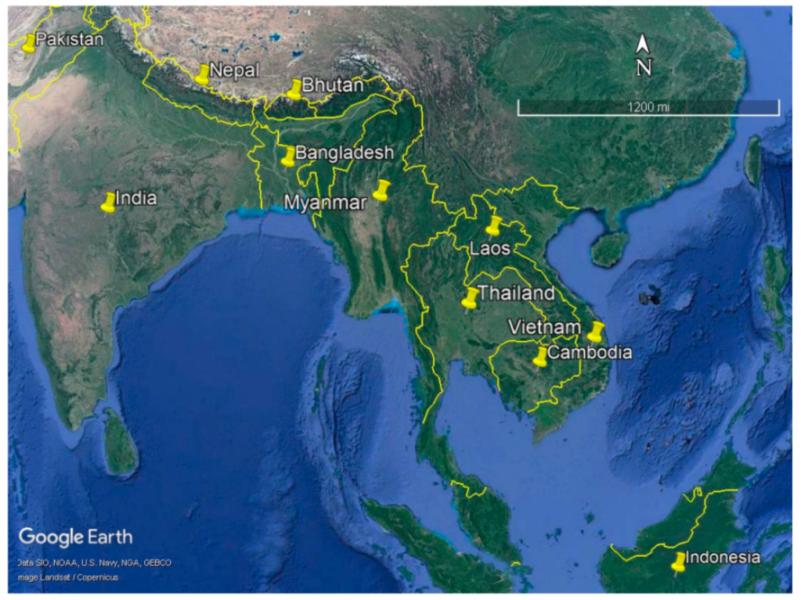
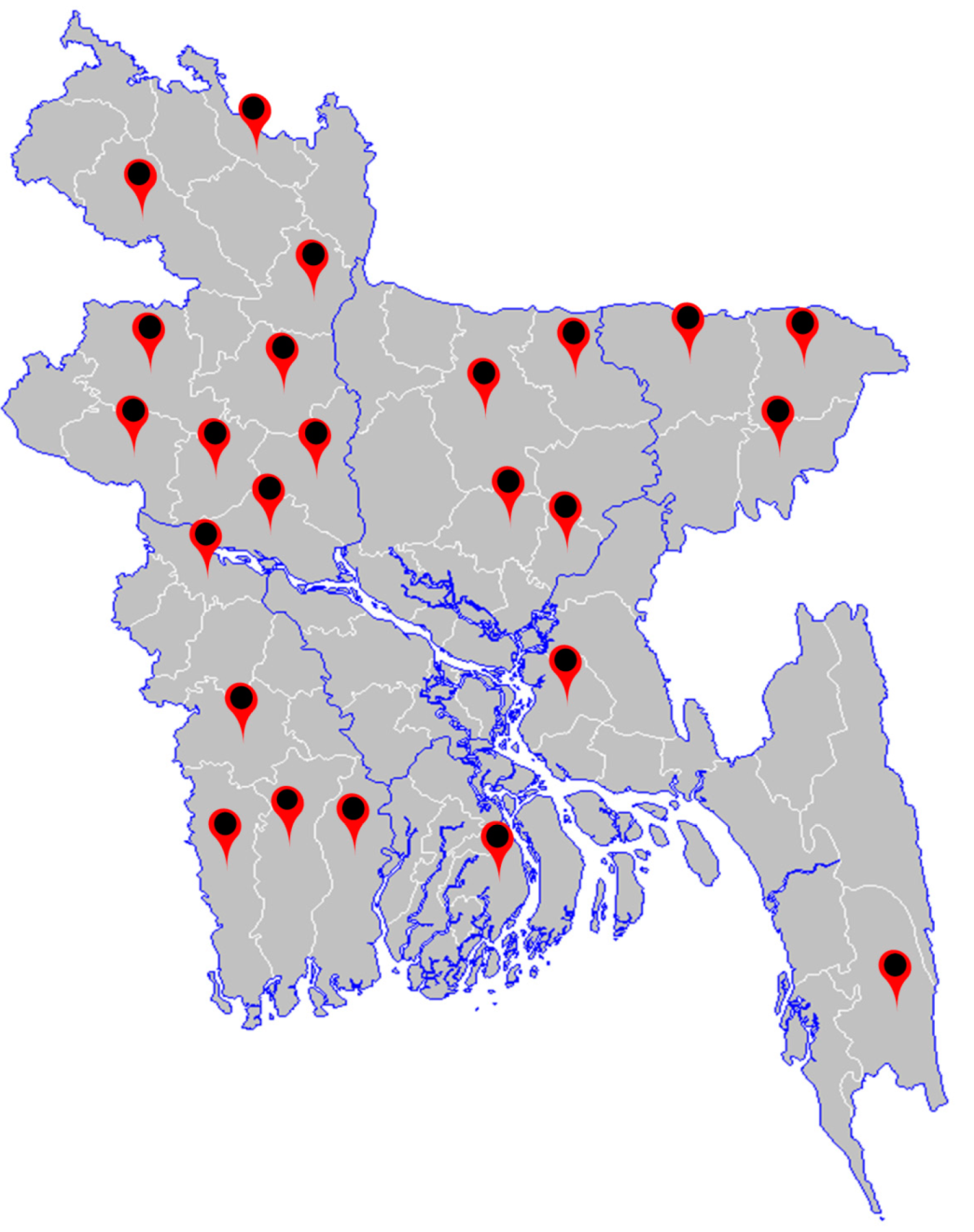
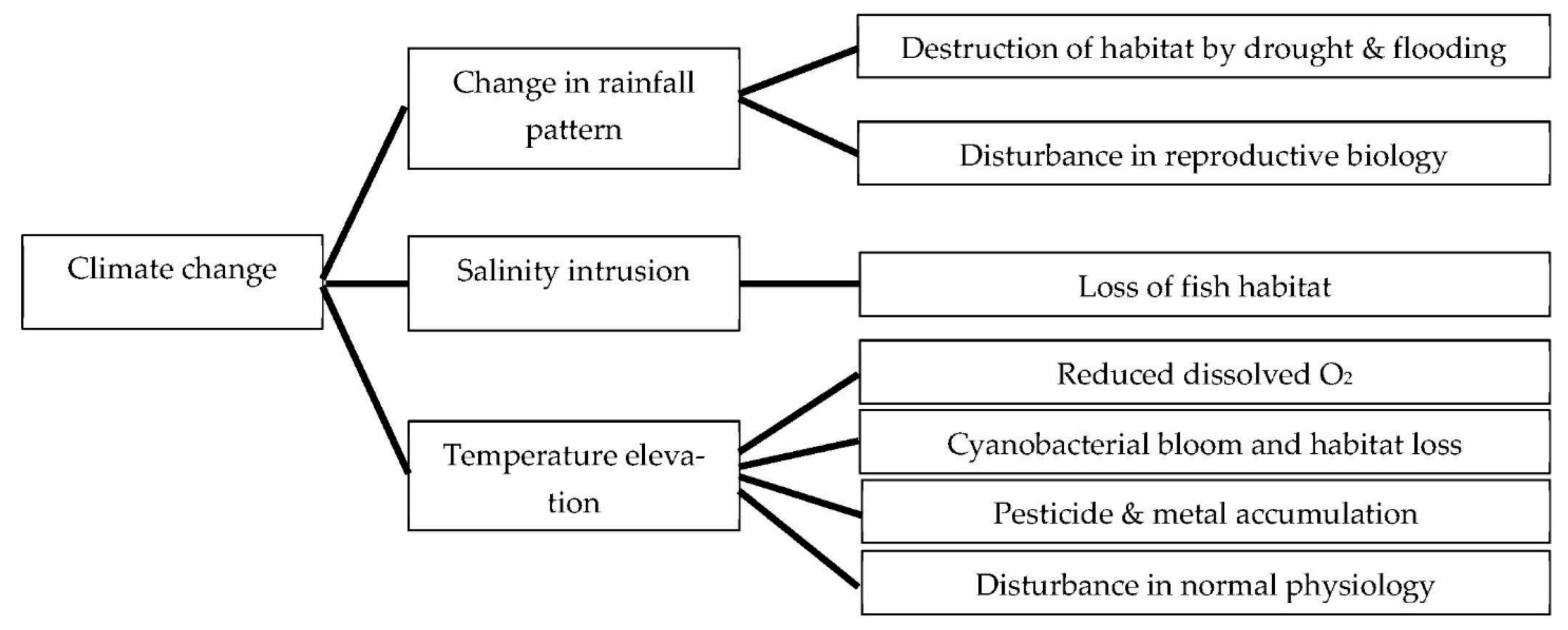
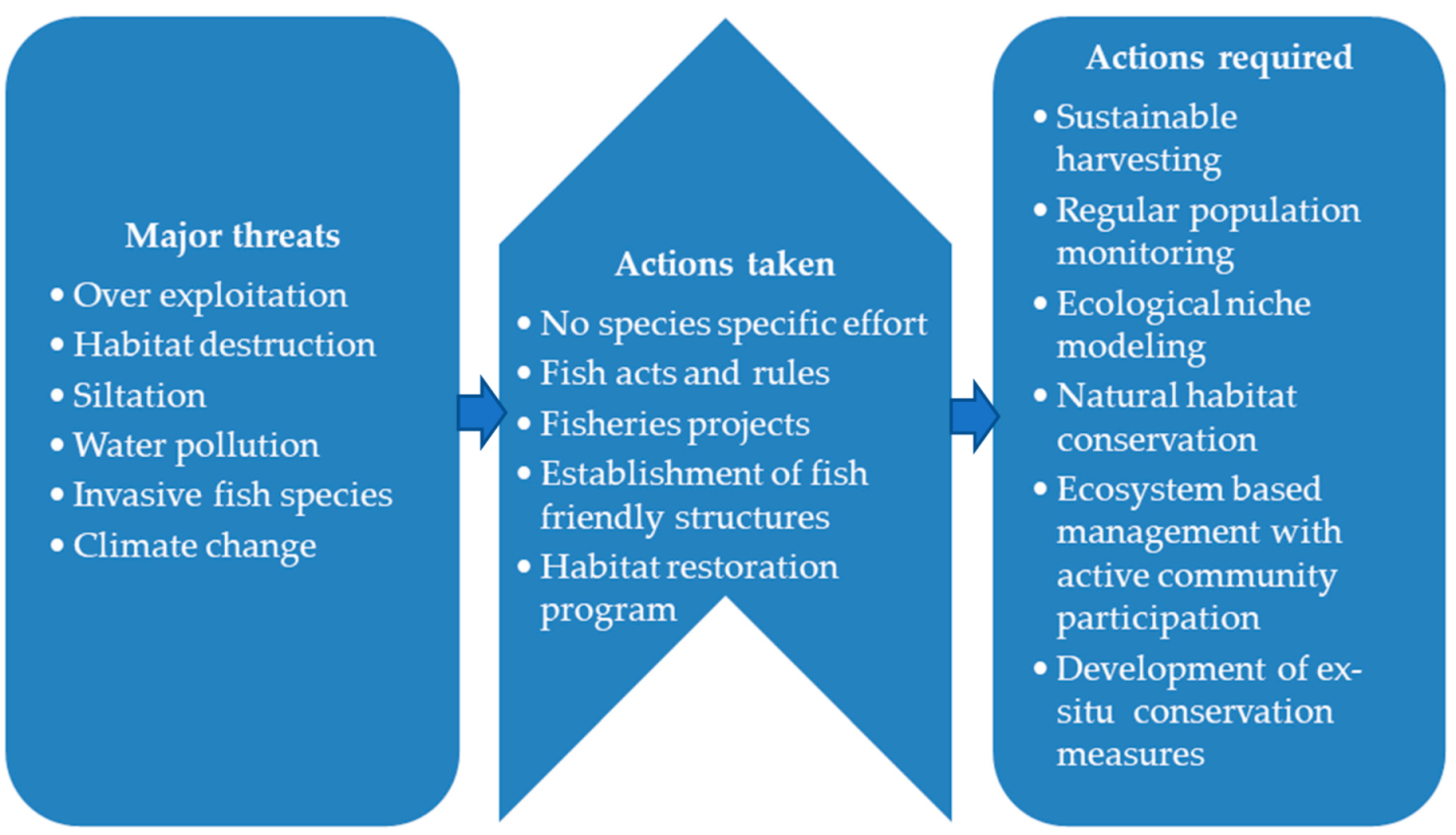
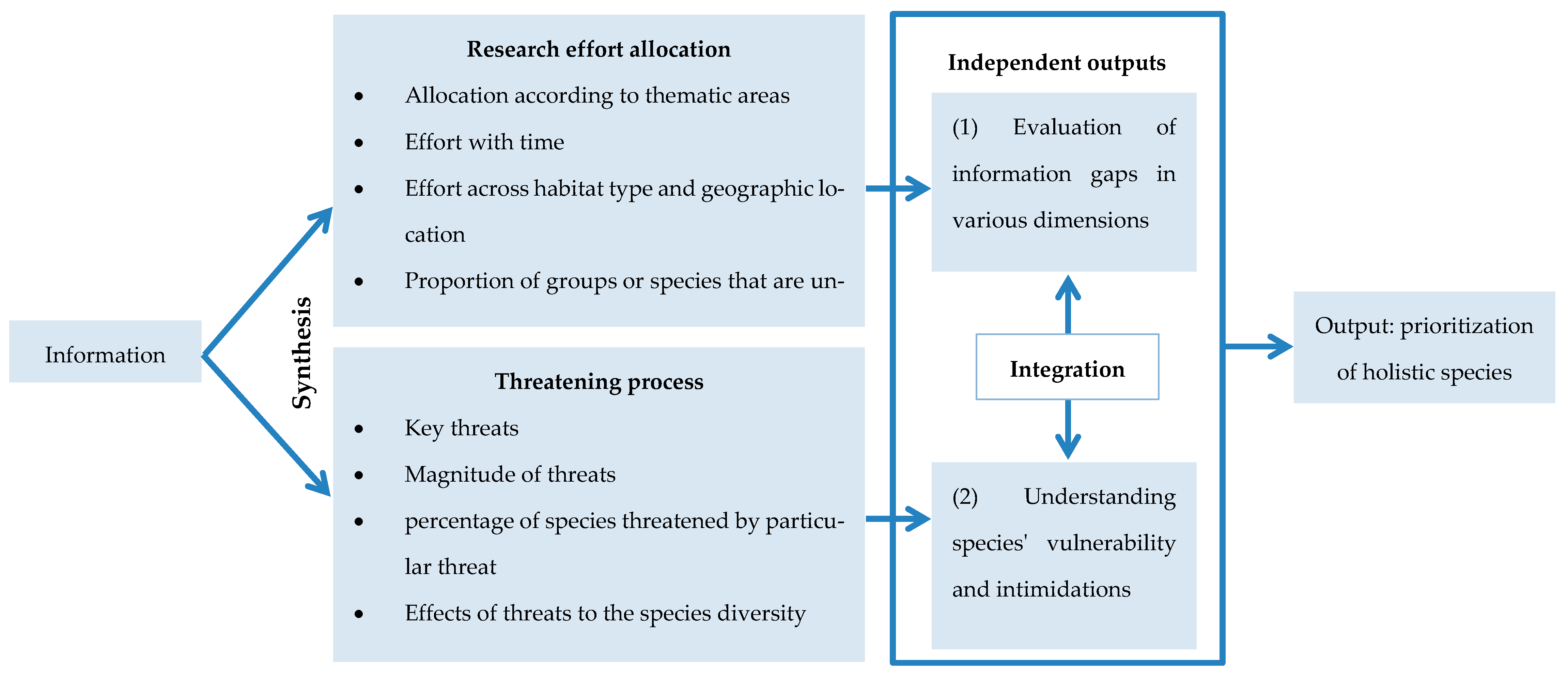
| Length (cm) | Weight (gm) | References |
|---|---|---|
| 16.1–21 (TL) | 20–45 | [4] |
| 28.1–42.2 (TL) | 70–257 | [26] |
| 6.2–81.5 (TL) | 1.35–2364 | [27] |
| 10.2–41.5 (TL) | - | [26] |
| 4.08–19.2 (SL) | - | [22] |
| Name of the Wetlands with District | References |
|---|---|
| Padma River, Rajshahi | [40,41] |
| Meghna River, Bhola, Chandpur | [4,42] |
| Choto Jamuna River, Naogaon | [43] |
| Brahmaputra River, Gaibandha | [44] |
| Old Brahmaputra River, Mymensingh | [45,46] |
| Khiru River, Mymensingh | [47] |
| Banar River, Mymensingh | [10] |
| Teesta River, Lalmonirhat | [48] |
| Ghaghat River, Gaibandha | [49] |
| Atrai River, Dinajpur | [50] |
| Punarbhaba River, Dinajpur | [50] |
| Turag River, Gazipur | [51] |
| Kangsha River, Someshwari River, Netrokona | [52] |
| Someshwari River, Netrokona | [53] |
| Sangu River, Bandarban | [54] |
| Lohalia River, Patuakhali | [55] |
| Andharmanik River, Patuakhali | [56] |
| Payra River, Patuakhali | [57] |
| Sibsa River, Khulna | [58] |
| Rivers of Sundarbans, Khulna, Bagherhat and Satkhira | [59] |
| Bhairab River, Jessore | [60] |
| Surma River, Chela River, Katakhali Khal, Mirza Khal, Chhatak, Sunamganj | [11] |
| Kushiyara River, Maulvibazar | [61] |
| Juri River, Sylhet | [62] |
| Shari-Goyain River, Sylhet | [63] |
| Tanguar Haor, Sunamganj | [64,65] |
| Hakaluki Haor, Moulvibazar | [66,67] |
| Dekar Haor, Sunamganj | [68,69] |
| Hail Haor, Moulavibazar | [70] |
| Chalan Beel, Natore, Pabna, Sirajganj, Naogaon, Bogra | [71,72] |
| Chinadi Beel, Narsingdi | [13] |
| Dhanu River, Kishoreganj | [16] |
| Chapaigachi Beel, Kushtia | [73] |
| Name of the Habitats | Area (ha) | Production (kg/ha) |
|---|---|---|
| A. Open waters | ||
| i. Floodplains | 2,651,567 | 294 |
| ii. River and tributaries | 8,53,863 | 389 |
| iii. Beels | 114,161 | 903 |
| iv. Kaptai Lake | 68,800 | 185 |
| v. Sundarbans | 177,700 | 118 |
| B. Closed waters | ||
| i. Ponds | 404,497 | 5059 |
| ii. Prawn/Shrimp farms | 257,888 | 1047 |
| iii. Baors | 5671 | 1934 |
| iv. Seasonal cultured water bodies | 151,942 | 1487 |
| Pollutant Type | Point Sources | Non-Point Sources |
|---|---|---|
| Pathogens | Raw sewage | Agricultural runoff and waste |
| Solid urban waste | Leachate from septic tank, waste of animal | |
| Excreta of human and animal | ||
| Heavy metals | Industrial discharges mainly from tannery and textile industries | Pesticide runoff |
| Mine effluents | Smelting | |
| Power plants | ||
| Pharmaceutical wastes | ||
| Organic chemicals | Industrial discharges mainly from tannery and textile industries | Agricultural runoff |
| Wastes from urban areas | Runoff from agro farms, pasture, and household wastes | |
| Nutrients | Wastewater of treatment plants | Agricultural runoff |
| Excreta of human and animal | Household wastes | |
| Thermal | Electric power plants | |
| Effluents from industries | ||
| Sedimentation | Construction related runoff from sites, smaller than 20,000 m2 | Construction related runoff from sites, larger than 20,000 m2 |
| Agricultural runoff | ||
| Soil erosion | ||
| Radioactivity | Natural occurring radioactivity |
| Name of Act, Ordinance and Regulations | Applicable Area | Major Scopes |
|---|---|---|
| East Bengal protection and conservation of Fish Act 1950 | East Pakistan | Protects all types of aquatic organisms and water bodies. |
| The Bangladesh Fisheries Development Corporation Act, 1973 | Bangladesh | Fisheries Development Corporation was created under this act. |
| The protection and conservation of fish (amendment) ordinance, 1982 | Bangladesh | This amendment was brought to make the previous acts more effective. |
| The protection and regulations for conservation of fish rules, 1985 | Bangladesh | Fisheries conservation. |
| The new fisheries management policy, 1988 | Bangladesh | Provides provisions for leasing Fisheries resources to real fisherman. |
| National Environment Policy, 1995 | Bangladesh | Restoration of aquatic waterbodies |
| Aquatic environment protection law | Bangladesh | Protects habitats of aquatic organisms. |
| National Fisheries Policy, 1998 | Bangladesh | Development of fisheries sector through various conservation efforts including maintenance of biodiversity and ecological balance. |
| National Water Policy, 1999 | Bangladesh | Ensuring suitable environment for fishes and other aquatic organisms. |
| National Land Use Policy, 2001 | Bangladesh | Protection of decaying inland water bodies. |
| Project Name | Duration | Scale of Project | Major Scopes |
|---|---|---|---|
| Community Based Fisheries Management (CBFM) Project | 1995–2007 | 10 rivers (partly), 7 beels and two baor sites in east, north, south and central Bangladesh |
|
| Fourth Fisheries Project (FFP) | 1999–2004 | 49 sites covering 33 of the 64 districts in Bangladesh |
|
| Management of Aquatic Ecosystem through Community Husbandry (MAECH) Project | 1998–2003 | Kangsha-Malijhi site from the north-central, the Turag-Bangshi site from the central and the Hail Haor from the northeast part of Bangladesh |
|
| Name of Structure | Water Body | District |
|---|---|---|
| Sariakandi fish pass | Between Jamuna and Bangali River | Bogra, Rajshahi |
| Kasimpur regulator and fish pass | Manu River | Moulovibazer, Sylhet |
| Jugini regulator and fish pass | Lohajong River | Tangail, Dhaka |
| Moricherdana fish pass | Mohanonda River | Chapainawabganj, Rajshahi |
| Research Activities | References |
|---|---|
| Details about the keratinization of its skin | [91] |
| Origin, form and network of cranial nerves | [92] |
| Identification of 3-Hydroxyretinol (Vitamin a3), a chromogen in the liver oil of B. bagarius | [93] |
| An insight of its skin | [23] |
| Some of its morphometric and meristic characteristics and its comparison with some other species of genus Bagarius | [22] |
| A detail on the morphology and histology of its digestive tract | [20] |
| Study on some deformities of this species from Nepal | [94] |
| Food and feeding habit | [31,33] |
| Length-weight relationship from Indus River, Pakistan, Ganga River, India and Ravi River, north-western India | [25,26,27] |
| Studies on its genetics | [29,30,95] |
| Post-harvest processing | [75] |
| Morphometric and meristic features of this fish | [18] |
| Features and status in Bangladesh | [21] |
| Its availability status in the Padma and Meghna river, Bangladesh | [4] |
| Effects of organochlorine and organophosphate pollution on its reproductive physiology | [96] |
Publisher’s Note: MDPI stays neutral with regard to jurisdictional claims in published maps and institutional affiliations. |
© 2021 by the authors. Licensee MDPI, Basel, Switzerland. This article is an open access article distributed under the terms and conditions of the Creative Commons Attribution (CC BY) license (https://creativecommons.org/licenses/by/4.0/).
Share and Cite
Saha, S.; Nasren, S.; Pandit, D.; Mian, S. An Overview of the Biological Features, Distribution, and Conservation of a Critically Endangered Riverine Catfish, Bagarius bagarius (Hamilton, 1822), in the Natural Waters of Bangladesh. Conservation 2021, 1, 350-367. https://doi.org/10.3390/conservation1040027
Saha S, Nasren S, Pandit D, Mian S. An Overview of the Biological Features, Distribution, and Conservation of a Critically Endangered Riverine Catfish, Bagarius bagarius (Hamilton, 1822), in the Natural Waters of Bangladesh. Conservation. 2021; 1(4):350-367. https://doi.org/10.3390/conservation1040027
Chicago/Turabian StyleSaha, Shuva, Shamima Nasren, Debasish Pandit, and Sohel Mian. 2021. "An Overview of the Biological Features, Distribution, and Conservation of a Critically Endangered Riverine Catfish, Bagarius bagarius (Hamilton, 1822), in the Natural Waters of Bangladesh" Conservation 1, no. 4: 350-367. https://doi.org/10.3390/conservation1040027
APA StyleSaha, S., Nasren, S., Pandit, D., & Mian, S. (2021). An Overview of the Biological Features, Distribution, and Conservation of a Critically Endangered Riverine Catfish, Bagarius bagarius (Hamilton, 1822), in the Natural Waters of Bangladesh. Conservation, 1(4), 350-367. https://doi.org/10.3390/conservation1040027







